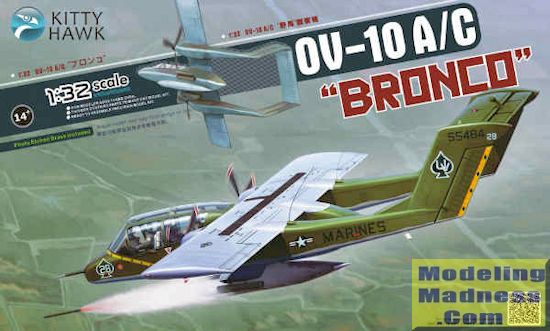
Kitty Hawk 1/32 OV-10A/C 'Bronco'
| KIT #: | KH 32004 |
| PRICE: | $ |
| DECALS: | Six options |
| REVIEWER: | Scott Van Aken |
| NOTES: |

| HISTORY |
In the early '60s, there was a requirement from all US Armed Services for a Light Attack and Reconnaissance Aircraft (LARA). The aircraft should also be able to perform the function as a COIN (COunter INsurgency) aircraft as well. This meant that it needed to be able to carry a variety of ordnace in addition to having internal guns. It should also be easy to maintain and equally easy to fly. North American's entry into the field was what was eventually to become the OV-10 'Bronco'.
It is powered by two small turboprops, has four 20mm cannon in a short weapons pod and is also capable of handling various ordnance including 2.75 and 5 inch rocket pods, 1,000 bombs, marker rockets and Sidewinder missiles for self defense. There is an aft cargo area that can handle two stretchers or five fully equipped troops.
The OV-10 was first introduced in the last few years of the Vietnam War as a replacement FAC (Forward Air Controller) to replace the Cessna O-2A. It was an instant success as it was armed, better protected and faster than the O-2. It was also used by several Marine Corps Squadrons and by one (perhaps two) Navy squadrons as well. After the end of the war, the OV-10 was still in use by regular USAF squadrons in both the US and overseas. It is one of the few aircraft that was not used by the USAF Air National Guard, those units getting the OA-37B instead. The final USAF OV-10 was retired in the late 1980s with the last USMC versions being retired in the early 1990s. Some are still flying with air forces in central and south America.
| THE KIT |
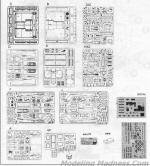 This is Kitty Hawk's second 1/32 Bronco having released the later OV-10D late last year. This kit is very much like the previous offering save for having the different bits to make the A/C variant. The kit comes in a rather large box full of superbly molded grey sprues. The detailing is just like you find on modern kits with crisply engraved panel lines and lightly done panel rivet detail.
This is Kitty Hawk's second 1/32 Bronco having released the later OV-10D late last year. This kit is very much like the previous offering save for having the different bits to make the A/C variant. The kit comes in a rather large box full of superbly molded grey sprues. The detailing is just like you find on modern kits with crisply engraved panel lines and lightly done panel rivet detail.
The kit comes with a nicely done etched fret which is mostly for intakes, wing spoilers, seat harnesses and a few other smaller bits. A very nice addition is a rectangular weight that fits under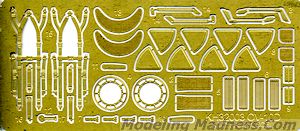 the floor of the cockpit, allowing the completed model to properly sit on all three gear. Boom aircraft are notorious for being tail heavy and this alleviates the issues of finding a place to put the weight. The cockpit tub includes two nicely molded seats as well as raised detail on the side consoles and the instrument panels. Decals are supplied for those who wish to use them on the two main instrument panels. There are also the usual control sticks and rudder pedals along with p.e. throttle levers.
the floor of the cockpit, allowing the completed model to properly sit on all three gear. Boom aircraft are notorious for being tail heavy and this alleviates the issues of finding a place to put the weight. The cockpit tub includes two nicely molded seats as well as raised detail on the side consoles and the instrument panels. Decals are supplied for those who wish to use them on the two main instrument panels. There are also the usual control sticks and rudder pedals along with p.e. throttle levers.
Underneath this construct fits the nose gear well. The instructions would have you fully assemble this along with the gear strut and nose wheel prior to attaching it to the underside of the cockpit piece. I would do some dry fitting to see if the gear could be attached after the fuselage is closed up. The kit also comes with a complete FLIR pod and attaching hardware as the nose of the model can be displayed open to view this item. A full troop bay in the rear is provided and it looks like this can have the rear door posed open if you so wish, though the instructions do not specifically show it.
Both of the sponsons have full gun bays with covers that can be left off to show the machine guns located within. The kit is also designed to have both of the side entrance windows posed up to show off the interior. Those few times I have seen this aircraft, usually only one side was open. Support braces and handles for these windows is part of the package.
The kit also includes two fully detailed engines to hang on the wings. These are attached to bulkheads that fit onto the main gear wells and then this assembly is trapped between the boom halves. Even if you wish to model the kit with one or both of the engines closed up, you still need to install them to have a mounting for the intakes and the prop. Their added weight is also taken into consideration to keep the model from tail sitting. Each of the boom assemblies is three main pieces with a separate top. To this assembly are fit the exhaust and the chaff/flare dispensers.
The total wing is six main sections. Two fit onto the fuselage section and four fit to outside the booms. The flaps are molded in the deployed position, and this includes the outer bits which look like ailerons. Roll control is from wedge shaped brakes that extend from the upper wing. These are rarely deployed on the ground. While the rudders are molded in the static position, the elevator is a separate piece.
The kit comes with a goodly assortment of things to hang under the airplane. For the centerline there is a drop tank, while under the sponsons you can put bombs or rocket pods. There is a pylon under each wing that can take either fuel tanks, Sidewinder missiles or rocket pods. Unless going into combat or an air show, about all that was carried was a centerline tank.
 What makes this kit different from the previous boxing is a new A sprue. This sprue contains a new nose, instrument panels, exhaust and a pair of new pylons.
What makes this kit different from the previous boxing is a new A sprue. This sprue contains a new nose, instrument panels, exhaust and a pair of new pylons.
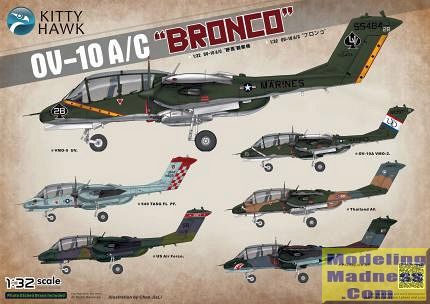 Instructions are the usual, well drawn, booklet that consists of 26 construction steps plus several steps for the ordnance and a load out diagram. A full color painting and markings guide is provided for six aircraft. The box art plane is from VMO-5 in Marine Green over Light Gull Grey with a white upper wing. The other USMC plane is from VMO-2 and in the same scheme. Two USAF planes are included. The initial offering is an overall ADC Grey or Light Gull Grey plane from the 549 TASG. The instructions state it is
Instructions are the usual, well drawn, booklet that consists of 26 construction steps plus several steps for the ordnance and a load out diagram. A full color painting and markings guide is provided for six aircraft. The box art plane is from VMO-5 in Marine Green over Light Gull Grey with a white upper wing. The other USMC plane is from VMO-2 and in the same scheme. Two USAF planes are included. The initial offering is an overall ADC Grey or Light Gull Grey plane from the 549 TASG. The instructions state it is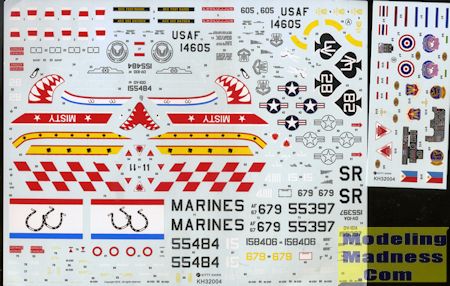 white and that is not correct. The other is in the later Euro I scheme and with the 20th TASS at Shaw AFB. For the foreign contingent we have a Thai Air Force OV-10C in SEA camouflage and finally a Philippine AF plane in a rather unique scheme of green/grey/brown over light grey. This aircraft has low visibility markings and a large shark mouth. The large decal sheet is nicely printed, though the red looks a bit too bright to my eyes. Those not wanting to use kit markings already have several options from the aftermarket folks.
white and that is not correct. The other is in the later Euro I scheme and with the 20th TASS at Shaw AFB. For the foreign contingent we have a Thai Air Force OV-10C in SEA camouflage and finally a Philippine AF plane in a rather unique scheme of green/grey/brown over light grey. This aircraft has low visibility markings and a large shark mouth. The large decal sheet is nicely printed, though the red looks a bit too bright to my eyes. Those not wanting to use kit markings already have several options from the aftermarket folks.
| CONCLUSIONS |
This looks to be just as nice a kit as the previous OV-10D and has a much greater range of possible camo schemes. It seems to me to be very nicely detailed, but I'm sure we will soon see detail sets for it as resin does have the ability to provide finer details than injected plastic.
| REFERENCES |
http://en.wikipedia.org/wiki/North_American_Rockwell_OV-10_Bronco
August 2015 Thanks to Glen and Kitty Hawk Models for the preview kit. You can find this kit at your favorite hobby shop or on-line retailer soon. If you would like your product reviewed fairly and fairly quickly, please contactthe editor or see other details in the